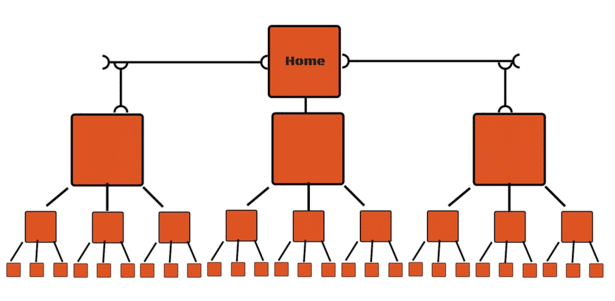The structure and navigation of your website is critical for great SEO, but is often overlooked. Crawlers use site structure to generate a “main topic” for your site, then make inferences about related content.
For example: A site that sells Ford vehicles, with related content being different types of Ford vehicles – Taurus, Focus, Escape, etc.
It’s so easy to focus more on the design or get caught up in a game plan that isn’t beneficial for ranking well in search results. This common mistake turns your site away from a “main topic” structure and towards an incoherent mess. We experienced this issue first-hand and found a way to improve rankings. It’s never too late to restructure your website navigation!
The Problem:
Too Many Main Categories
Site architecture and navigation are important for SEO because it affects keyword rankings and traffic to your site. We have a client whose top navigation was structured with seven main categories, six of which were not even a main focus for their business to attract leads (Blog, About Us, Resources, Credentials, Etc). By structuring the top navigation with these categories, they were telling Google crawlers that all of those seven categories were equally important, when in reality they weren’t. Google didn’t know what the main purpose of the site was because there was too much information at the top level.
The site structure looked something like this:
The site had too many top navigation categories that weren’t a main focus to the business, and other very important pages were hidden deeper in the site, thus losing the “juice” or authority it needed from crawlers to show higher up in search rankings.
The Solution:
Less Main Categories, More Supporting Pages and Internal Linking
Our team did keyword research and talked with the client about their main focus as a business and what they wanted to be known for. We decided to create a more “shallow” site with supporting content so that Google crawlers could easily access and index the content and know exactly what the site was about. The supporting content told Google more about our top level categories and that our site was strongly focused in a particular area.
Our new structure looks something like this:
We structured the site so that prominent pages and keyword phrases would be higher in the site navigation. The top three main categories told the story of what the website was about, and under those main categories we added sub pages with supporting content and internal linking back to those main pages. It is important to have supporting pages that link back to your main category to better the chances of ranking well for those competitive keywords. We also made sure that every page had a proper URL hierarchy that matched the site structure.
The Results:
After making the site structure changes to 1) optimize around fewer main navigation categories and 2) add sub pages and supporting content, we saw a drastic position change in keyword rankings. Since the site navigation change, our client has on average gone down 10 positions (closer to #1) in Google search. We hope to decrease that number even more by adding more supporting pages under each main category.
Below is a table that shows the position change and impression change from a few keywords/pages we optimized around. We left out the specific keywords to keep the client anonymous. The site structure change was made on December 17.
(NEW) December 17-March 12 compared to (OLD) September 17-December 17
Overall, we learned that it is important for all websites to put a careful plan in place when deciding their site structure. Make sure to ask yourself what keywords and pages you want to focus around, and build your site structure from there. A “shallow” navigation with supporting pages and internal linking is a great step toward ranking well and bringing traffic to your site. If your site is structured properly, you can allow yourself to build more supporting content in the future so you can tell Google crawlers even more about your site.
For example: “This site is about a Ford dealership that sells new & used vehicles”, as opposed to “This site is a Ford dealership that sells a lot of different cars”.







